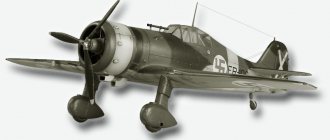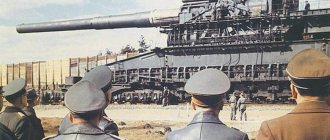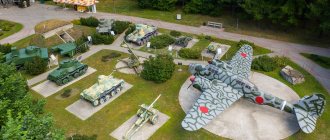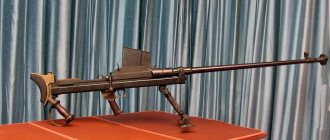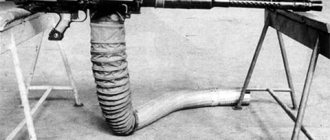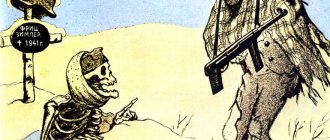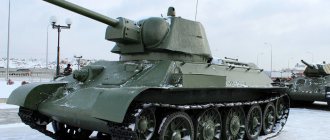The Mark-V was a heavy British tank used in the First World War. It was the successor to the series of British diamond-shaped tanks, and, like the previous Mk, was produced in two modifications: the “male” with a machine gun and cannons, and the “female” with only machine guns.
Mk-V
◄ Back
Forward ►
Image 1 of 10
History of the MK - V tank
The first Mk-V tanks began to arrive to British troops in May 1918, after it became clear that the Mk-IV tanks were severely deficient. In total, 400 Mk-Vs were produced before the end of the war - 200 males and 200 females.
The Mk-V, compared to previous tanks in the Mk line, was greatly changed both externally and internally. It was equipped with a new four-speed gearbox, as well as a Ricardo engine, created specifically for tank building. Thanks to these and other innovations, one person could now directly control the tank.
Externally, the tank was somewhat different due to the air intakes of the new cooling system, which were mounted on the sides of the vehicle. The commander's cabin was also enlarged, and an additional machine gun was installed in the rear of the tank.
Excerpt describing Mark V
– Ah, maman, comment est ce que vous ne comprenez pas que le Saint Pere, qui a le droit de donner des dispenses... [Ah, mamma, how don’t you understand that the Holy Father, who has the power of absolution...] At this time the lady the companion who lived with Helen came in to report to her that His Highness was in the hall and wanted to see her. - Non, dites lui que je ne veux pas le voir, que je suis furieuse contre lui, parce qu'il m'a manque parole. [No, tell him that I don’t want to see him, that I’m furious against him because he didn’t keep his word to me.] “Comtesse a tout peche misericorde, [Countess, mercy for every sin.],” said the young blond man as he entered. a man with a long face and nose. The old princess stood up respectfully and sat down. The young man who entered did not pay attention to her. The princess nodded her head to her daughter and floated towards the door. “No, she’s right,” thought the old princess, all her convictions were destroyed before the appearance of His Highness. - She is right; but how is it that we didn’t know this in our irrevocable youth? And it was so simple,” the old princess thought as she got into the carriage. At the beginning of August, Helen's matter was completely determined, and she wrote a letter to her husband (who loved her very much, as she thought) in which she informed him of her intention to marry NN and that she had joined the one true religion and that she asks him to complete all the formalities necessary for divorce, which the bearer of this letter will convey to him. “Sur ce je prie Dieu, mon ami, de vous avoir sous sa sainte et puissante garde. Votre amie Helene.” [“Then I pray to God that you, my friend, will be under his holy, strong protection. Your friend Elena"] This letter was brought to Pierre's house while he was on the Borodino field. The second time, already at the end of the Battle of Borodino, having escaped from Raevsky’s battery, Pierre with crowds of soldiers headed along the ravine to Knyazkov, reached the dressing station and, seeing blood and hearing screams and groans, hastily moved on, getting mixed up in the crowds of soldiers. One thing that Pierre now wanted with all the strength of his soul was to quickly get out of those terrible impressions in which he lived that day, return to normal living conditions and fall asleep peacefully in his room on his bed. Only under ordinary conditions of life did he feel that he would be able to understand himself and all that he had seen and experienced. But these ordinary living conditions were nowhere to be found. Although cannonballs and bullets did not whistle here along the road along which he walked, on all sides there was the same thing that was there on the battlefield. There were the same suffering, exhausted and sometimes strangely indifferent faces, the same blood, the same soldiers' greatcoats, the same sounds of shooting, although distant, but still terrifying; In addition, it was stuffy and dusty. Having walked about three miles along the big Mozhaisk road, Pierre sat down on the edge of it. Dusk fell on the ground, and the roar of the guns died down. Pierre, leaning on his arm, lay down and lay there for a long time, looking at the shadows moving past him in the darkness. It constantly seemed to him that a cannonball was flying at him with a terrible whistle; he shuddered and stood up. He didn't remember how long he had been here. In the middle of the night, three soldiers, having brought branches, placed themselves next to him and began to make a fire. The soldiers, looking sideways at Pierre, lit a fire, put a pot on it, crumbled crackers into it and put lard in it. The pleasant smell of edible and fatty food merged with the smell of smoke. Pierre stood up and sighed. The soldiers (there were three of them) ate, not paying attention to Pierre, and talked among themselves. - What kind of person will you be? - one of the soldiers suddenly turned to Pierre, obviously, by this question meaning what Pierre was thinking, namely: if you want something, we will give it to you, just tell me, are you an honest person? - I? me?.. - said Pierre, feeling the need to belittle his social position as much as possible in order to be closer and more understandable to the soldiers. “I am truly a militia officer, only my squad is not here; I came to the battle and lost my own. - Look! - said one of the soldiers. The other soldier shook his head. - Well, eat the mess if you want! - said the first and gave Pierre, licking it, a wooden spoon. Pierre sat down by the fire and began to eat the mess, the food that was in the pot and which seemed to him the most delicious of all the foods that he had ever eaten. While he greedily bent over the pot, picking up large spoons, chewing one after another and his face was visible in the light of the fire, the soldiers silently looked at him. -Where do you want it? You tell me! – one of them asked again. – I’m going to Mozhaisk. - Are you now a master? - Yes. - What’s your name? - Pyotr Kirillovich. - Well, Pyotr Kirillovich, let’s go, we’ll take you. In complete darkness, the soldiers, together with Pierre, went to Mozhaisk. The roosters were already crowing when they reached Mozhaisk and began to climb the steep city mountain. Pierre walked along with the soldiers, completely forgetting that his inn was below the mountain and that he had already passed it. He would not have remembered this (he was in such a state of loss) if his guard, who went to look for him around the city and returned back to his inn, had not encountered him halfway up the mountain. The bereitor recognized Pierre by his hat, which was turning white in the darkness. “Your Excellency,” he said, “we are already desperate.” Why are you walking? Where are you going, please? “Oh yes,” said Pierre. The soldiers paused. - Well, have you found yours? - said one of them. - Well, goodbye! Pyotr Kirillovich, I think? Farewell, Pyotr Kirillovich! - said other voices. “Goodbye,” said Pierre and headed with his driver to the inn. “We have to give it to them!” - Pierre thought, taking his pocket. “No, don’t,” a voice told him. There was no room in the upper rooms of the inn: everyone was occupied. Pierre went into the yard and, covering his head, lay down in his carriage. As soon as Pierre laid his head on the pillow, he felt that he was falling asleep; but suddenly, with the clarity of almost reality, a boom, boom, boom of shots was heard, groans, screams, the splashing of shells were heard, the smell of blood and gunpowder, and a feeling of horror, the fear of death, overwhelmed him. He opened his eyes in fear and raised his head from under his overcoat. Everything was quiet in the yard. Only at the gate, talking to the janitor and splashing through the mud, was some orderly walking. Above Pierre's head, under the dark underside of the plank canopy, doves fluttered from the movement he made while rising. Throughout the yard there was a peaceful, joyful for Pierre at that moment, strong smell of an inn, the smell of hay, manure and tar. Between two black canopies a clear starry sky was visible. “Thank God this isn’t happening anymore,” thought Pierre, covering his head again. - Oh, how terrible fear is and how shamefully I surrendered to it! And they... they were firm and calm all the time, until the end... - he thought. In Pierre's concept, they were soldiers - those who were at the battery, and those who fed him, and those who prayed to the icon. They - these strange ones, hitherto unknown to him, were clearly and sharply separated in his thoughts from all other people.
TTX
General information:
- Combat weight – 30 tons “male”, 28 tons “female”;
- Crew – 8 people.
Dimensions:
- Case length – 8060 mm;
- Body width – 3950 mm “male”, 3320 mm “female”;
- Height – 2630 mm;
Reservations:
- Armor type – steel;
- Body forehead – 6-14 mm/deg;
Weapons:
- Caliber and brand of gun - 2 × 57-mm "Hotchkiss" L/40 ("male");
- Machine guns - 4 × 8 mm "Hotchkiss" ("male"), 5 × 7.7 mm "Vickers" and 1 × 8 mm "Hotchkiss" ("female").
Mobility:
- Engine type: carburetor (“Ricardo”, 6 cylinders);
- Engine power – 150 hp. (at 1000 rpm);
- Highway speed - 6.5 km/h;
- Specific ground pressure - 0.90 kg/cm²;
- The wall to be overcome is 1.5 m;
- The ditch to be overcome is 4.5 m;
- Fordability - 1 m.
Modifications
In total, two main modifications of the Mk-V were produced:
- Mark V* - Tadpole Tail. It was lengthened to overcome 3.5 meter German trenches on the Hindenburg Line. A total of 645 Mark V* were produced. It weighed 33 tons “male” and 32 tons “female”. Also on this version, a compartment for transporting infantry was installed, however, due to poor ventilation, the soldiers were incapacitated after transportation, so it was decided to transport cargo and equipment in it;
- Mark V**. This version of the Mark-V with a more powerful engine of 225 hp. appeared in 1918. A total of 197 examples were built.
When in April 1918 the battle with German tanks near Villers-Brenton showed the complete incapacity of the “females”, instead of one machine gun it was decided to install a cannon on them. This modification became conventionally called “hermaphrodite”, and most of the already released Mk-V females were converted into it.
The fate of the monument
During the German occupation, they wanted to take away the “diamonds” for melting down, but they didn’t get around to it. But in the mid-90s, a barbaric “restoration” took place, as a result of which the tanks were painted poisonous green, a la “the dream of a buyer from the housing office.” Along with the caterpillars.
True, in 2009, the “fives” were restored to a higher quality - among other things, weapons models were installed on them. A significant part of the amount was given by the British, who took care of the rare exhibits. But all the work was carried out right there, at the Lugansk Diesel Locomotive Plant.
(Photo: Timur Sherzad / WARHEAD.SU)
Due to recent events, the equipment on the pedestals began to be reactivated - the most famous was the IS-3 with the inscription “To Lviv!” A funny rumor was born - supposedly the “diamonds” would also be restored, given armor, weapons replaced, and sent to the front. But even if such a crazy idea occurred to someone, fortunately they did not dare to implement it - there can be no benefit from “diamonds” in a war of the 21st century.
That’s why the “fives” still stand on their pedestals today. Available for detailed external inspection to anyone interested.
Application
The Mk-V, along with the Mk-IV, was the main British tank in the First World War. Despite a number of shortcomings, Mk-Vs actively participated in a number of battles and were also used by the armies of other countries. In November 1918, as many as 77 vehicles were handed over to the French. There were several Mk-Vs in the US Army. There were Mk-Vs in the troops of the White Guard and the interventionists in Russia. Some of these tanks were later captured by the Red Army, and named "Ricardo" - after the name of the engine company, which was cast on the cylinder block.
After World War I, for a long time, only Mk V and Mk V* tanks were in service with the British Army. Some of their copies were in Poland, Estonia, Latvia and even Japan.
Mk-Vs took part in such an important event of the Russian Civil War as the Third Battle of Tsaritsyn. The operation in June 1919, which ended with the capture of the city by the troops of Peter Wrangel, involved 16 tanks - 8 males and 8 females. Another “female” contained the British crew of Captain Cox.
After the First World War, the Mk V was used as a bridge layer and in a sapper version. It remained in service in Canada until the late 1930s.
Links
- www.youtube.com/watch?v=S2D9gW9bYRk&feature=related
- www.youtube.com/watch?v=tWu1GyBLYAg&feature=related
- www.youtube.com/watch?v=Tzk53VoKmtI&feature=related
| Medium tanks | Little Willie Mk B Mk C |
| Heavy tanks | Big Wheel Landship · |
| Other developments | Gun Carrier Ark Bridge Layer |
| Italic projects not embodied in metal are noted | |
Memory of a tank
Much more Mk V tanks have survived than its predecessors. Including several of these tanks can be seen here in Russia.
- A captured British Mark V tank in Arkhangelsk, which the Red Army captured here in 1920. Also in Arkhangelsk, 13 more tanks were captured and transferred to other Russian cities. For example, Mark V “hermaphrodite” can be seen in Kharkov;
- Another “hermaphrodite” was installed in Lugansk;
- Mk V with a rather interesting coloring is on display at the Central Museum of Armored Weapons and Equipment in Kubinka;
- The Mk V is on display at London's Imperial War Museum.

